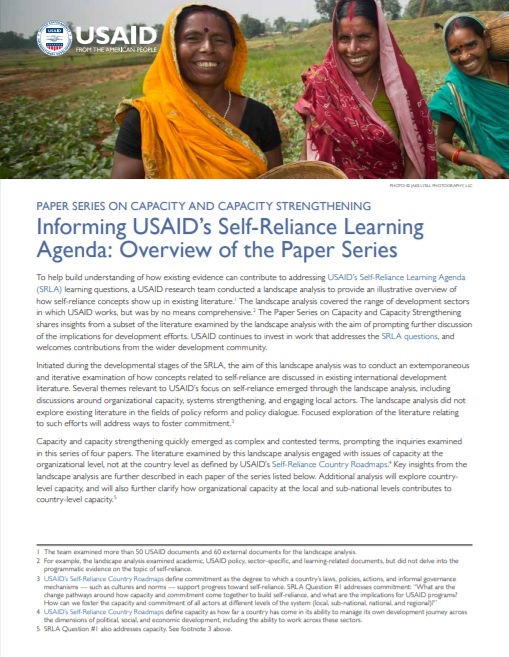Speeches Shim
The Paper Series on Capacity and Capacity Strengthening shares insights gleaned from a subset of the literature examined by the SRLA landscape analysis, with the aim of prompting further discussion. It notes that capacity and capacity strengthening are complex and contested terms, with practical implications for how development practitioners approach capacity strengthening with local partners. The literature examined by this landscape analysis engaged with issues of capacity at the organizational level, not at the country level as defined by USAID’s Self-Reliance Country Roadmaps, which examine how far a country has come in its ability to manage its own development journey across several dimensions including the ability to work across them. Additional analysis will explore country-level capacity, and will also further clarify how organizational capacity at the local and sub-national levels contributes to country-level capacity.
Key insights from the Paper Series on Capacity and Capacity Strengthening are further discussed in each paper:
- Inquiry 1: What are the Different Perspectives That Development Practitioners Have on Organizational Capacity?
The literature reviewed for Inquiry 1 demonstrates a lack of conceptual clarity around key terms, including “capacity” and “capacity strengthening.” As a consequence, fundamental assumptions about how capacity should be assessed, by whom, and for what purposes often remain implicit and unquestioned. Notably, the literature examined by this landscape analysis most often discussed capacity at the level of organizations, and occasionally individual actors. - Inquiry 2: How do Development Practitioners Determine What Capacity Already Exists Within an Organization?
As discussed in Inquiry 2, some authors suggest that the imbalanced power dynamic between development practitioners and local actors can lead to generic statements that local capacity is lacking across the board, rather than assessments that identify specific shortages or skill gaps. - Inquiry 3: How Should Development Practitioners Approach Strengthening Organizational Capacity with Local Actors?
Inquiry 3 describes how adopting a facilitative approach to strengthening the capacity of local organizations prioritizes developing their ability to continue pursuing development objectives independent of external support. - Inquiry 4: How Can Development Practitioners Strengthen Their Own Capacities to Better Facilitate the Journey to Self-Reliance?
The literature reviewed for Inquiry 4 notes that administrative bottlenecks, risk-averse policies and practices, management deficits, high rates of personnel turnover, lack of understanding of local context, and staff skill gaps can undermine efforts by development practitioners to strengthen the capacity of local partners and partner organizations.
USAID continues to invest in work that addresses the SRLA questions, and welcomes contributions from the wider development community. USAID is excited to learn from you. Please contact us at SRLA@usaid.gov to share your experiences or evidence.


Comment
Make a general inquiry or suggest an improvement.